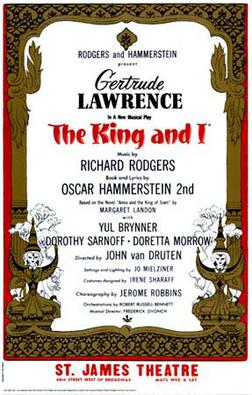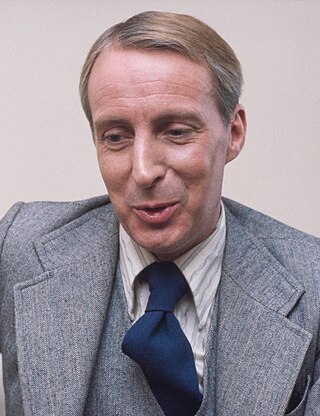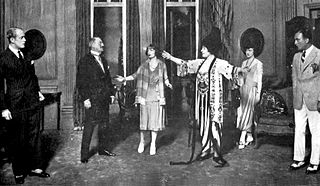Related Research Articles

Carousel is the second musical by the team of Richard Rodgers (music) and Oscar Hammerstein II. The 1945 work was adapted from Ferenc Molnár's 1909 play Liliom, transplanting its Budapest setting to the Maine coastline. The story revolves around carousel barker Billy Bigelow, whose romance with millworker Julie Jordan comes at the price of both their jobs. He participates in a robbery to provide for Julie and their unborn child; after it goes tragically wrong, he is given a chance to make things right. A secondary plot line deals with millworker Carrie Pipperidge and her romance with ambitious fisherman Enoch Snow. The show includes the well-known songs "If I Loved You", "June Is Bustin' Out All Over" and "You'll Never Walk Alone". Richard Rodgers later wrote that Carousel was his favorite of all his musicals.

The King and I is the fifth musical by the team of Rodgers and Hammerstein. It is based on Margaret Landon's novel Anna and the King of Siam (1944), which is in turn derived from the memoirs of Anna Leonowens, governess to the children of King Mongkut of Siam in the early 1860s. The musical's plot relates the experiences of Anna, a British schoolteacher who is hired as part of the King's drive to modernize his country. The relationship between the King and Anna is marked by conflict through much of the piece, as well as by a love to which neither can admit. The musical premiered on March 29, 1951, at Broadway's St. James Theatre. It ran for nearly three years, making it the fourth-longest-running Broadway musical in history at the time, and has had many tours and revivals.

The Odd Couple is a play by Neil Simon. Following its premiere on Broadway in 1965, the characters were revived in a successful 1968 film and 1970s television series, as well as several other derivative works and spin-offs. The plot concerns two mismatched roommates: the neat, uptight Felix Ungar and the slovenly, easygoing Oscar Madison. Simon adapted the play in 1985 to feature a pair of female roommates in The Female Odd Couple. An updated version of the 1965 show appeared in 2002 with the title Oscar and Felix: A New Look at the Odd Couple.

The Gielgud Theatre is a West End theatre, located on Shaftesbury Avenue, at the corner of Rupert Street, in the City of Westminster, London. The house currently has 994 seats on three levels.

Ian William Richardson was a British actor from Edinburgh, Scotland. He was best known for his portrayal of machiavellian Tory politician Francis Urquhart in the BBC's House of Cards (1990–1995) television trilogy, as well as the pivotal spy Bill Haydon in Tinker Tailor Soldier Spy (1979). Other notable screen work included a portrayal of Sherlock Holmes in two films, as well as significant roles in Brazil, M. Butterfly, and Dark City.

Luther Adler was an American actor who worked in theatre, film, television, and directed plays on Broadway.
Henry Goodman is a RADA trained British actor. He has appeared on television and radio, in film and in the theatre.

John Michael Terence Wellesley Denison was an English actor. He often appeared with his wife, Dulcie Gray, with whom he featured in several films and more than 100 West End theatre productions.

Donald Cook was an American stage and film actor who had a prolific career in pre-Code Hollywood films and on Broadway. Cook is perhaps best known for his film roles in The Public Enemy (1931), Safe in Hell (1931), Baby Face (1933), and Viva Villa! (1934), as well as for his stage role as David Naughton in Claudia, which ran for a total of 722 performances on Broadway between 1941 and 1943. He was the first actor to play Ellery Queen.
Allyn Ann McLerie was a Canadian-born American actress, singer and dancer who worked with many of Golden Age musical theatre's major choreographers, including George Balanchine, Agnes de Mille, and Jerome Robbins.
Robert Kemp (1908–1967) was a Scottish playwright. Along with Tom Fleming and Lennox Milne, he was a founder of the Edinburgh Gateway Company.

Robert Urquhart was a Scottish character actor who worked on the stage, for British television, and in film. His breakthrough role was Paul Krempe in The Curse of Frankenstein in 1957, along with Peter Cushing and Christopher Lee.

What Every Woman Knows is a four-act play written by J. M. Barrie. It was first presented by impresario Charles Frohman at the Duke of York's Theatre in London on 3 September 1908. It ran for 384 performances, transferring to the Hicks Theatre between 21 December 1908 and 15 February 1909.
Mark Lee Dexter is an English actor who trained at RADA.

The Audience is a play by the British playwright and screenwriter Peter Morgan. The play centres on weekly meetings, called audiences, between Queen Elizabeth II and her prime ministers. It premiered in the West End in 2013, at the Gielgud Theatre. A Broadway production opened in 2015, also starring Mirren. A West End revival played in London in 2015 starring Kristin Scott Thomas in the lead role.

King Charles III is a 2014 play in blank verse by Mike Bartlett that premiered at the Almeida Theatre in London. The play is a fictional account of the accession and reign of King Charles III of the United Kingdom, and the limiting of the freedom of the press after the News International phone hacking scandal.
William Barr Friedlander was an American songwriter and theater producer who staged many Broadway shows in the 1920s and 1930s. Most of them were musical comedies. Early successes included Moonlight (1924) and Mercenary Mary (1925). Later productions received mixed reception. His longest-running production was the comedy Separate Rooms, which ran from March 1940 to September 1941.
The Gateway Theatre was a Category C listed building in Edinburgh, Scotland, situated on Elm Row at the top of Leith Walk.

The Circle: a Comedy in Three Acts is a play by W. Somerset Maugham. It was first produced at the Haymarket Theatre, London on 3 March 1921, and has been revived several times in the West End and on Broadway.
References
- 1 2 3 4 Hischak, Thomas S. (2009). Broadway Plays and Musicals: Descriptions and Essential Facts of More Than 14,000 Shows Through 2007. McFarland. p. 62. ISBN 9780786434480 . Retrieved February 24, 2017.
- 1 2 Edelman, Rob; Kupferberg, Audry (2002). Matthau: A Life. Taylor Trade Publishing. p. 72. ISBN 9780878332748 . Retrieved February 24, 2017.
- 1 2 Lachman, Marvin (2014). The Villainous Stage: Crime Plays on Broadway and in the West End. MacFarland. p. 137. ISBN 978-0786495344 . Retrieved February 24, 2017.
- 1 2 Ariel (August 21, 1954). "The Week in Wireless: Listening Without a Break to Good Music" . The Age. Melbourne: 18. Retrieved February 24, 2017.
- ↑ Wallace W. Robins (February 1956). "Books". Bulletin of the Atomic Scientists. XII (2): 60–61. Retrieved February 24, 2017.
- 1 2 Williamson, Audrey (1956). Contemporary Theatre: 1953–1956. Rockliff. pp. 33–35. Retrieved February 24, 2017.
- ↑ Zolotow, Sam (January 1, 1954). "Morgan Play Bows Feb. 8". The New York Times . Retrieved February 17, 2019.
- ↑ "Charles Morgan: Three Plays (product description)". Oberon Books. Retrieved February 24, 2017.
- ↑ Anthony Hartley (February 26, 1954). "Contemporary Arts – Theatre – The Burning Glass". The Spectator. Retrieved February 24, 2017.
- ↑ "Dramatic & Musical Routes". Billboard. February 13, 1954. p. 61. Retrieved February 24, 2017.
- ↑ "The Burning Glass". IBDb (Internet Broadway Database). Retrieved February 24, 2017.
- ↑ "The Burning Glass". Playbill. Retrieved February 24, 2017.
- ↑ Edinburgh Gateway Company (1965), The Twelve Seasons of the Edinburgh Gateway Company, 1953 - 1965, St. Giles Press, Edinburgh, p. 45
- ↑ "Archive". Bromley Little Theatre. Retrieved February 24, 2017.